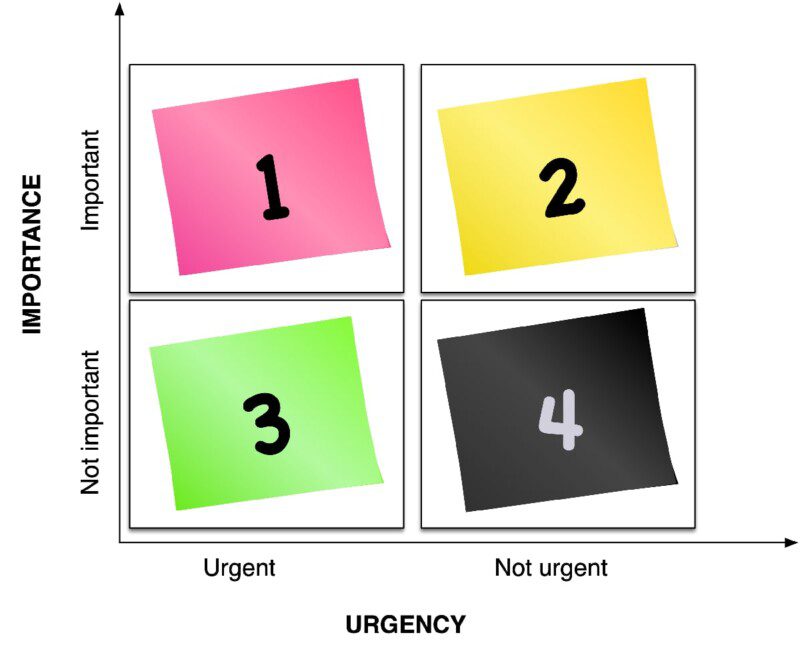Efficient time management is like a secret weapon for boosting productivity and steering any business towards success. Have you heard of the Covey Time Management quadrant ? It’s like a map with four zones shaping how you tackle your day.
What is the Covey time management quadrant concept?
The Covey’s time management quadrant concept provides a structure for job prioritisation that enhances productivity and efficiency. In light of this, Steven Covey, the creator of the Seven Habits of Highly Effective People model, develop this idea. It employs a four-quadrant approach to assist you in classifying every assignment, duty, and stage of your life according to:
Urgency:
Tasks and responsibilities need quick action or attention.
Importance:
Those with high importance or high values of goals
The main purpose of this method is to improve the personal and professional relationships as well as promote growth and achievements.

Time Management Quadrants:
Each quadrant serves a unique purpose and is design to help you prioritise your tasks and responsibilities. These quadrants are as follows:
Quadrant 1: Urgent and important
Quadrant 2: Not Urgent but important
Quadrant 3: Urgent but not important
Quadrant 4: Not urgent and not important
Let’s have a look at each time management quadrant now for understanding them clearly.
Quadrant 1: Urgent and important
Q1 involves responsibilities or tasks that are relevant to important results and require immediate attention. The items in ist quadrant are basically stressors due to their urgency and importance. So you must be familiar with this type of task and categorise them depending on the need.
Items that fall into quadrant 1 have following deadlines such as deadlines, direct relationship with time sensitive goals and effort on them. Quadrant is situated top left in the matrix.
Quadrant 2: Not urgent but important
Quadrant 2 activities are those that need careful planning and extra steps directly contribute to your smart goals. These tasks are not urgent but important represent activities that bring discipline and commitment. By focusing on Q2 items, you schedule activities within your control that go well with your overall objectives.
Moreover, the second quadrant focuses on proactive behaviours such as strategic planning, skill development and relationship building. Moreover, investing time and effort in Q2 activities enables progress and success. Consequently, they address key areas that leave a high impact on your personal and professional growth over time.
Quadrant 3: Urgent but no important
Quadrant 3 focuses on activities that are urgent but their significance in the huge scheme is neglect. These tasks progress due to poor planning or ignoring important tasks from Q1 and Q2. They tend to disrupt productivity and serve as distractions while drawing attention from critical problems. Items in q3 can be decreased or in some cases eliminated by addressing underlying planning issues and focussing on high priority tasks.
This quadrant is located in the bottom left of the fours quadrants for time management. It thus highlights the significance of distinguishing between urgency and importance to optimise workflow efficiency and accomplish meaningful purpose towards goals.
Quadrant 4: Not urgent and not important
In the four quadrants for time management, Quadrant 4 is like a hidden treasure of tasks that can be reduced or eliminate altogether. These are the least stressful items which are not directly tied to urgent goals or cause time pressure. Just think of them as the lightweights in your workload, perfect for decluttering your to do list. By recognizing what falls into Q4 , you gain clarity on what tasks hold the least priority.
Advantages of using Covey time management quadrant:
Using the covey time management quadrant , there are many advantages in the workplace including:
Improve productivity:
Order of this method plays an important role in determining what to put first in your life and how to efficiently approach these tasks. Make sure you make an organised list of tasks that can help you complete more and more tasks in less time.
Clear habits and work life balance:
Using this method can help you to identify which quadrants you spend most of your time and assess your own behaviour and you can develop clear habits of focusing only on q1 and q2 items. With more productive habits at work, you are in position to find time for the things that matter most to you outside of work as well.
Conclusion:
We discuss time management quadrants at length in this article. Thus, time management apps improve everything in our lives. It helps to foster efficient workflow management and goal achievement. In short, covey time management quadrant concept offers a unique approach to prioritise tasks depending on the urgency and importance.
Want to streamline your task management? Have a look at our productivity apps to optimise your time management and task completion.


